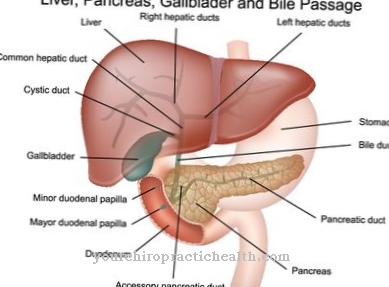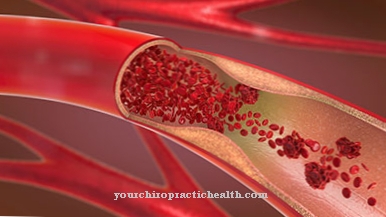Under one Fibrosis, which are often called sclerosis refers to a hardening of tissue and organs, which is due to an overproduction of collagen fibers. Fibrosis often affects the lungs, liver, kidneys, heart or skin. Fibrosis is not a disease in its own right, but rather a symptom that can have various underlying diseases.
What is fibrosis?
.jpg)
© designua - stock.adobe.com
The term fibrosis comes from the Latin "fibra" which can be translated in German as "fiber". The term thus refers to a pathological increase in the tissue fibers of the body, which can impair the function of the organ affected by fibrosis.
Fibrosis of the lungs can manifest itself, for example, as shortness of breath, while liver fibrosis can manifest itself in high blood pressure and impaired brain function up to a coma. The easiest way to think of fibrosis is as a scarring. In a healthy person, after the wound has healed, more connective tissue develops at the injured area, which becomes visible as a scar.
Even with fibrosis there is damage to the affected organ, which can have a wide variety of causes and to which the body reacts with scarring.
causes
The causes for the onset of fibrosis are extremely diverse. They range from normal aging processes and long-term medication to circulatory disorders, infections and alcohol abuse to chronic inflammations such as hepatitis.
But harmful environmental influences such as gases, vapors and organic dust, for example from mold or house dust mites, can cause allergic fibrosis in the long term. Autoimmune diseases can also lead to fibrosis. The starting point of fibrosis is always damage to the organ, be it through wear and tear, inflammatory reactions or an excessive lifestyle, to which the body has to respond with progressive scarring.
If the underlying disease is not treated appropriately, the organ tissue is increasingly penetrated by scar tissue, which cannot take over the function of the healthy tissue cells.
Symptoms, ailments & signs
Fibrosis can occur in different regions of the body and usually leads to different symptoms. If the fibrosis occurs directly on the skin, the skin usually becomes thick and wrinkled. This also leads to reduced aesthetics, so that most patients do not feel comfortable with these complaints and suffer from inferiority complexes or from a significantly reduced self-esteem.
Furthermore, there is also restricted mobility and inflammation of the joints. These can continue to spread to the internal organs if not treated properly. Patients with fibrosis of the skin also often suffer from difficulty swallowing. In the worst case, fibrosis of the liver can lead to inflammation and cirrhosis of the liver.
If this is not treated, the affected person dies due to the complaints. It also leads to high blood pressure. Fibrosis of the lungs can also develop, with patients suffering from pneumonia and severe breathing difficulties.
The life expectancy of the patient is extremely limited and the quality of life is also significantly reduced. Since the disease spreads to neighboring regions of the body, immediate treatment by a doctor is necessary.
Symptoms of liver fibrosis (scleroderma):
- Cirrhosis of the liver
- Inflammation of the liver
- high blood pressure
Symptoms of fibrosis of the lungs (pulmonary fibrosis):
- see the article ⇒ pulmonary fibrosis
Diagnosis & course
Existing fibrosis is diagnosed using a tissue sample that the doctor can examine under the microscope for changes that are typical of fibrosis. Imaging methods such as x-rays, ultrasound and computed tomography can also be used.
An X-ray examination is a frequently used method, especially if pulmonary fibrosis is suspected, while the liver can be examined better with the ultrasound device. Fibrosis of the liver, also known as cirrhosis of the liver, can also be detected by palpating the organ. A conversation between doctor and patient is also important for a comprehensive diagnosis, in order to be able to link any previous illnesses with fibrosis.
Function tests of the relevant organ are also part of the diagnosis. If the hardening of the tissue can be stopped in time, a life with little or no restrictions is possible. If the disease has progressed so far that the affected organ is no longer functional, organ failure occurs.
Complications
A number of complications can arise as a result of fibrosis. Depending on the severity of the disease, the organs and tissue become harder and less elastic as the disease progresses.This can lead to dysfunction and pain, especially in the hands and fingers. Joint inflammation is also common.
Difficulty swallowing can occur because the esophagus loses its elasticity and virtually freezes. Later on, the entire gastrointestinal tract can lose its function, leading to shortness of breath and other complaints. The increased lung pressure can cause the right ventricle to enlarge and, in the long term, cause cardiac insufficiency.
If the kidneys are affected, chronic deficiency symptoms can lead to a lack of oxygen and high blood pressure. In advanced stages, fibrosis can cause kidney failure. If the disease is not treated by then at the latest, the other organs also gradually fail and the patient dies.
The prescribed medication can lead to complications during treatment. With a possible transplant, there is a risk that the organism will reject the donor organ and life-threatening infections will occur.
When should you go to the doctor?
A doctor's visit should take place as soon as the person concerned has the feeling that something is wrong inside their body. If you feel pressure, a diffuse feeling of illness or a decrease in normal performance, a doctor should be consulted. If swallowing difficulties or pain occurs over several days, a doctor should be consulted. If the symptoms increase in scope and intensity or if there are further symptoms, it is advisable to have these clarified by a doctor.
A medical examination is also necessary as soon as shortness of breath sets in. If there are problems with inhalation for no apparent reason or if the heart races, this is considered worrying. If sleep disorders set in, the blood pressure rises and a permanent feeling of warmth can be perceived, a doctor's visit is necessary. In the case of persistent functional impairments of various kinds, it is advisable for the person concerned to see a doctor.
If there are disorders of the gastrointestinal tract, an unwanted loss of weight or irregular urination, these observations should be investigated more closely and treated if necessary. This is especially true as soon as they occur repeatedly. Unusual and sudden changes in the complexion of the skin must also be clarified by a doctor. Thickening of the skin, a dry skin sensation and a feeling of tension should be discussed with a doctor.
Doctors & therapists in your area
Treatment & Therapy
Depending on the cause of the fibrosis occurring, the therapy options are varied. The treatment of fibrosis depends on the underlying disease. For example, if the fibrosis is inflammatory, the ultimate goal is to stop the inflammatory process. This can be done using cortisone preparations or immunosuppressants.
If the fibrosis is caused by toxins or alcohol abuse, avoidance of the causative substances is essential. Symptomatic treatment, such as an oxygen supply for fibrosis of the lungs, is also conceivable. Fibrosis cannot be completely cured, existing damage remains, which is why early treatment is of particular importance.
If the fibrosis is already in the end stage, there is the option of an organ transplant. If fibrosis is left untreated, it is fatal.
Outlook & forecast
Fibrosis is a change in tissue that often affects the lungs. However, the prognosis for such fibrosis does not look very good and, as a rule, it cannot be cured. In numerous cases, fibrosis leads to death. However, this disease can be delayed with appropriate treatment and the right medication.
Affected persons with fibrosis can have a positive influence on the outlook and prognosis through coordinated self-management. In addition, the prognosis depends on many different factors that can also have a positive effect on the entire course of the disease. These factors include, for example:
- the start of treatment (the earlier the treatment, the better)
- the damage already done in the lungs
- the rate at which the disease progresses
- the effectiveness with which the treatment works for the person concerned
Fibrosis is a serious condition that requires medical attention. However, in most cases the prognosis is far from positive. This disease is often fatal. Only postponing this disease is possible. Appropriate treatment can prevent serious complications.
prevention
Fibrosis can be prevented through a healthy lifestyle, such as moderate alcohol consumption and smoking cessation. A vaccination against the inflammatory disease hepatitis B is also useful. The body should be exposed to toxins and pollutants as little as possible. A normal body weight, a healthy diet and sufficient exercise strengthen the body and the immune system and should not be underestimated for the prevention of fibrosis.
Aftercare
In the case of fibrosis, there are usually no special measures or options for follow-up care available to those affected. The affected person is in any case dependent on an early diagnosis and detection of this disease so that further complications or complaints can be avoided. This disease cannot cure independently.
Furthermore, in the case of fibrosis, the diagnosis of the underlying disease is very important in order to limit it and then treat the symptoms causally. The fibrosis may also reduce the life expectancy of the person affected. However, life expectancy and the further course depend heavily on the underlying disease, so that no general course can be given.
Fibrosis is usually treated by taking medication. The person affected should ensure that they are taken regularly and that the dosage is correct so that the symptoms can be properly alleviated. If left untreated, fibrosis usually leads to death. With this disease, the patient also depends on the help and care of friends and family.
You can do that yourself
Fibrosis, synonymous with sclerosis, does not establish its own clinical picture, but describes a symptom that can be the expression of several different diseases. All causes of fibrosis have in common that functional tissue in certain organs is increasingly being replaced by collagenous connective tissue.
The tissue of the affected organs becomes harder (sclerotic) and the organ increasingly loses functionality because the built-in connective tissue, as a kind of replacement tissue, cannot take over any of the original organ functions.
In many cases, the fibrosis is only mildly developed and does not require any further treatment, so that there is no need to adapt everyday behavior or take self-help measures. If important organs such as the lungs, liver and others are affected, it is important to find out the cause of the sclerotization in order to be able to start combating the cause.
The fibrosis of the organ in question up to that point is irreversible. This means that while fibrosis can be stopped if its causes have been successfully eliminated, the disease cannot be reversed.
In some cases, self-help measures are urgently needed. For example, environmental conditions in a dusty environment (coal mining, aluminum processing, flour processing plants) can trigger pulmonary fibrosis (black lung). As a self-help measure, a change of occupation, or at least a change of job, comes into consideration.
If the onset of cirrhosis of the liver can be traced back to excessive and chronic alcohol consumption, the self-help measure consists of abstaining from alcohol consumption, which can be achieved, if necessary, through a rehab.






.jpg)




















